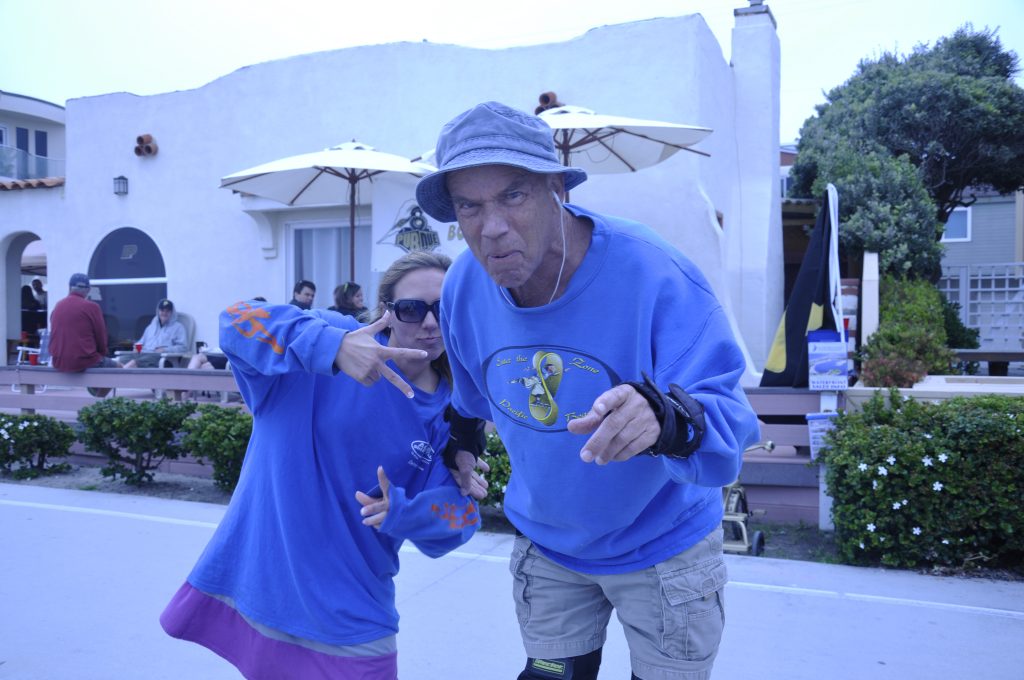Meeting SLOMO in Pacific Beach
I first met SLOMO in 2012, on a sunlit afternoon along the boardwalk at Pacific Beach. The scene was alive with the usual chaos — skateboarders weaving through crowds, families balancing dripping ice cream cones, the ocean’s rhythm pulsing in the background. And then, cutting through it all, came this figure on rollerblades: arms stretched wide, face lifted toward the sky, gliding with a serenity that seemed almost otherworldly.
At first, I thought he was just another eccentric beach character, the kind you expect to find in Southern California. But as I watched him move, something about his presence felt different. He wasn’t performing for attention; he was inhabiting a state of pure joy, a kind of meditative flow that radiated outward. When I learned his story — that he was once Dr. John Kitchin, a neurologist who had abandoned his career and wealth to become “SLOMO” — the encounter took on a deeper resonance.
His philosophy was deceptively simple: slow down, do what you love, and let yourself feel the divinity of joy. That day, I didn’t just meet a man on rollerblades; I met a living reminder that life doesn’t have to be a race. Watching him glide, I began to question my own pace, my own obsession with productivity and achievement.
Over time, his example has stayed with me. I’ve found myself taking things slower, savoring small pleasures, and remembering that happiness isn’t something to chase — it’s something to allow. Meeting SLOMO was more than a chance encounter; it was a turning point, a gentle nudge toward a life lived with more presence, more ease, and more joy.

The Life Before SLOMO
Dr. John Kitchin’s early life followed the classic trajectory of success. He studied medicine, specialized in neurology, and built a career diagnosing and treating disorders of the brain. His work was intellectually demanding, financially rewarding, and socially prestigious. He lived in a mansion in Del Mar, drove luxury cars, and invested wisely. By conventional standards, he had “made it.”
Yet beneath the surface, cracks began to show. Neurology is a field that deals with the most profound aspects of human suffering — dementia, Parkinson’s, strokes. Day after day, Kitchin confronted the fragility of the human mind. He saw patients lose their memories, their identities, their ability to function. The work was emotionally draining, and the bureaucratic grind of modern medicine only deepened his disillusionment.
Outside the hospital, his wealth did not translate into happiness. The mansion felt empty, the BMW was just a machine, and the IRA was a number on a screen. He was surrounded by symbols of success but starved of meaning.
The lab coat became a metaphor: a garment of authority, but also of confinement. It represented a life defined by external validation, by the expectations of society rather than the desires of the soul.

The Breaking Point
Every radical transformation begins with a moment of reckoning. For Kitchin, it was the realization that he was rich but not happy. He had achieved everything he was supposed to want, yet he felt hollow.
The breaking point came when he looked at his life and asked: Is this all there is?
Instead of ignoring the question, he confronted it head-on. He began to imagine a different existence, one not tethered to wealth or prestige. Slowly, the idea of leaving medicine took shape. It was not an impulsive decision but a deliberate act of liberation.
He sold his possessions, left behind his financial security, and moved to Pacific Beach. To outsiders, it looked like madness: why would a successful neurologist throw away everything? But to Kitchin, it was salvation.

The Birth of SLOMO
In Pacific Beach, Kitchin discovered rollerblading. At first, it was just a hobby, a way to exercise. But soon it became something deeper.
Gliding down the boardwalk, he felt a sensation of freedom. The rhythm of the blades, the balance of the body, the wind against his face — it was meditative, transcendent. Rollerblading was not just physical; it was spiritual.
He began to slow down, to savor each movement. Locals noticed his unique style: arms outstretched, body leaning into the glide, face serene. They started calling him SLOMO. The name stuck, and the persona was born.
SLOMO was not just a man on skates; he was a philosophy. He embodied the idea of slowing down in a fast world, of finding joy in simple motion.
The Philosophy of SLOMO

At the heart of SLOMO’s philosophy is the belief that joy is divinity. Rollerblading became his spiritual practice, a way to connect with something larger than himself.
Slowing Down in a Fast World
Modern life is defined by speed: deadlines, emails, commutes, productivity. We rush from one task to another, rarely pausing to breathe. SLOMO’s glide is a radical act of resistance. By moving slowly, he rejects the tyranny of speed.
The Neuroscience of Bliss
As a neurologist, Kitchin understood the brain. He knew that rollerblading tapped into flow states, releasing dopamine and endorphins. The sensation of gliding was not just psychological; it was neurological. He was literally rewiring his brain for joy.
Do What You Love
SLOMO’s message is simple: do what you love, and do it slow. For him, it was rollerblading. For others, it might be painting, gardening, or playing music. The point is not the activity but the authenticity.
Cultural Impact
In 2013, the documentary SLOMO brought Kitchin’s story to a wider audience. Directed by Josh Izenberg, the film captured his philosophy and his presence on the boardwalk. It went viral, resonating with viewers around the world.
Why did his story strike such a chord? Because it offered a counter-narrative to the rat race. In a culture obsessed with success, SLOMO embodied freedom. He showed that it is possible to walk away, to reinvent, to live authentically.
Pacific Beach became his stage. Locals saw him as a prophet, tourists as a curiosity. But beneath the spectacle was a profound message: happiness is not found in wealth but in motion, in slowing down, in living fully.
Lessons from SLOMO
What can we learn from SLOMO?
- Courage to Reinvent: It takes immense bravery to abandon a prestigious career and start anew.
- Prioritize Joy: Success without happiness is hollow. Joy must be central.
- Redefine Success: True success is not wealth but authenticity.
- Find Your Rollerblades: Everyone has their own path to joy. The challenge is to find it.
SLOMO reminds us that divinity is not in temples or doctrines but in the body, in motion, in the simple act of living authentically.
Conclusion: Liberation on Wheels
Dr. John Kitchin’s journey from neurologist to SLOMO is a modern parable. He traded wealth for freedom, prestige for joy, speed for slowness. His rollerblades became wings, carrying him into a life of authenticity.
In a world obsessed with productivity, his glide is a reminder to slow down. In a culture that equates success with wealth, his story is a reminder that happiness is the true measure.
SLOMO is not just a man on skates; he is a symbol of liberation. He shows us that it is possible to reinvent, to live authentically, to find divinity in joy.
So the next time you see a man gliding down Pacific Beach, arms outstretched, face tilted toward the sun, remember: that is SLOMO, the neurologist who became a prophet of joy.



